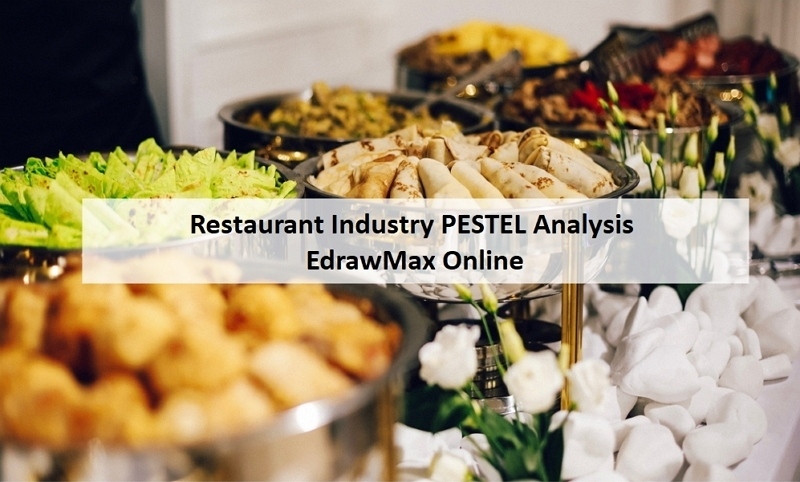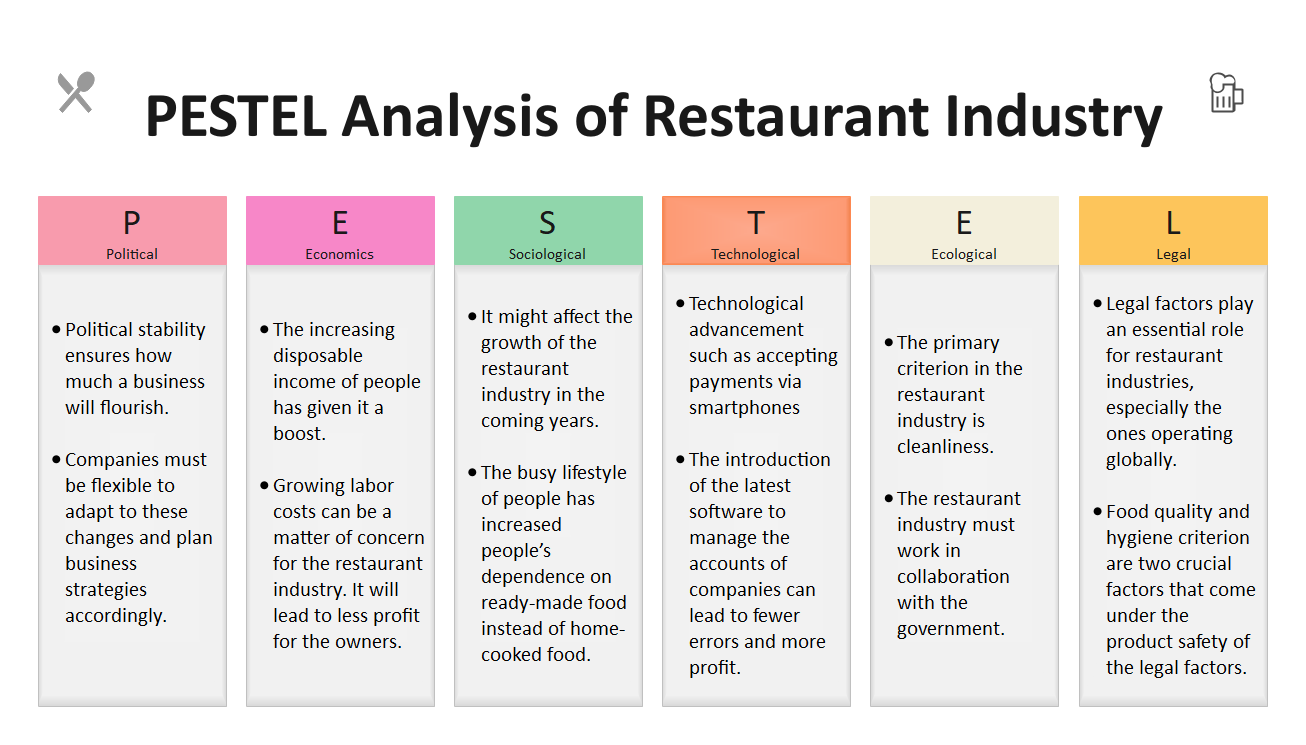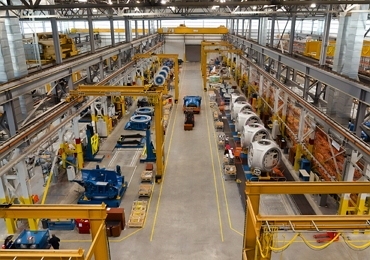Restaurant Industry PESTEL Analysis
Want to Create PESTEL Analysis?
EdrawMax is able to create free pestel analysis for software development teams with ease. Give it a try!

1. Introduction
There is no doubt that the food or restaurant industry is one of the largest and most profitable businesses globally. The restaurant industry is thriving! Thanks to the people’s inclination towards experimenting with food and their ever-changing preferences. It is one of the main reasons behind culinary diversity.
The management of a company uses PESTEL analysis to weigh the factors that can hinder or promote the industry's growth. Restaurant Industry PESTEL analysis can identify how political, economic, socio-cultural, technological, ecological, and legal issues can impact the conditions of the restaurant industry.
2. Background of Restaurant Industry
France takes pride in opening the first restaurant ever in the world. According to researchers, in 1765, A. Boulanger, a soup vendor, first introduced the restaurant concept. Even today, the French makes a significant contribution to the restaurant industry. The name restaurant refers to public eating place.
It is not just famous in France, but worldwide. There are broadly two categories, fast food, and casual dining. The functioning is similar to that of any retail store. Today the dining options are abundant, so the competition between them is pretty stiff and intense.
3. Restaurant Industry PESTEL Analysis
More and more people are willing to try their luck in making a fortune in the restaurant industry. Investors are eager to assess the situation before investing in this business, owing to the growing competition in this sector. PESTEL is one such business tool that empowers investors to evaluate the external factors that directly impact the business environment.
PESTEL is an acronym for Political, Economic, Social, Technological, Environmental, and Legal factors. This business strategy enables companies to study these macro-environmental factors to plan the company’s finances better. Such software is beneficial, especially, for start-ups helping them target the potential market. PESTEL analysis restaurant industry predicts growth opportunities as well as a potential threat for the industry.
Political Factors:
These factors assess the extent to which government policies interfere in the business. It can be the laws related to health and safety, taxation, trade policies, labor law, environmental law, restrictions on trade, and more.
- Political stability ensures how much a business will flourish. Government policies may change over time, owing to the changing scenarios of the area where this industry operates. Companies must be flexible to adapt to these changes and plan business strategies accordingly.
- The health and safety-related policies affect the restaurant industry the most. Businesses must take care of cleanliness and hygiene while carrying out cooking, packing, and delivering operations to abide by the guidelines related to health and safety.
- Taxation that affects the purchase and quality also influences the industry. It differs from country to country. Companies must plan their finances well, keeping this factor in mind.
Economic Factors:
These factors help businesses plan their short-term and long-term goals. Economic factors encompass economic growth, interest rate, exchange rate, inflation, the purchasing power of the consumer, and more.
- In general, the growing tendency of people to eat out has ensured better revenue for the restaurant industry. The increasing disposable income of people has given it a boost.
- Growing labor costs can be a matter of concern for the restaurant industry. It will lead to less profit for the owners.
- Similarly, fluctuating taxes on raw materials and ingredients can result in high prices of products. Thus, affecting the prices on the menu. A slow-growing or unstable economic growth is also a threat to the industry.
Social Factors:
Socio-cultural aspects that help the businesses develop a supply-demand model come under this factor. They are- traditions, cultural values & beliefs, population growth, age distribution, career attitude, and more. By studying these factors, companies can also determine a potential market.
- PESTEL analysis restaurant industry suggests that growing awareness about organic food is a social factor. It might affect the growth of the restaurant industry in the coming years.
- The busy lifestyle of people has increased people’s dependence on ready-made food instead of home-cooked food. It has proven to be a boost for the economy of the food industry.
- The growing population and its increasing demand, sensitivity towards transgender employees are some other social factors directly or indirectly influencing the restaurant industry.
Technological Factors:
Factors including innovation, automation, technical awareness, and more influence the production, distribution, and communication operations of a business come under the technical parameters.
- Technological advancement such as accepting payments via smartphones, ordering food online, and operating CCTV cameras from mobile phones has opened up, new revenues for the restaurant industry. Automation is the future of the restaurant industry.
- The introduction of the latest software to manage the accounts of companies can lead to fewer errors and more profit.
- Technology has also given companies the scope to experiment with their promotion strategies to reach more people quickly and leave a long-lasting impression.
Environmental Factors:
The ongoing environmental crisis has given rise to awareness about environmental factors. These include scarcity of raw material, recycling, pollution, carbon footprint, and others. Companies must follow the rules as sustainability is the key to success.
- The primary criterion in the restaurant industry is cleanliness. Apart from that, businesses must also develop strategies for recycling and waste management.
- The restaurant industry must work in collaboration with the government. It will help to lower the risks of environmental damage, which can occur because of them.
- The food industry must recognize and appreciate the tendency of their consumers to shift to a plant-based diet owing to the damage the meat industry might contribute to the environment. They must focus on materializing the long-term benefits of this shift.
Legal Factors:
Factor related to advertising, consumer rights, health concern, and product safety comes under this legal factor of PESTEL analysis. The breach of government policies becomes a legal matter.
- Legal factors play an essential role for restaurant industries, especially the ones operating globally. With the changing legislation, businesses must also change their strategies to grow and expand.
- Food quality and hygiene criterion are two crucial factors that come under the product safety of the legal factors.
- Besides the safety standards, maintaining minimum daily wages and the welfare of the employees are also some vital aspects that the restaurant industry must consider if they want to grow steadily in any given environment.
The restaurant industry is the most profitable since food is a basic necessity for survival. This industry operates round the clock. One of the many reasons for this success is that this industry offers a great deal of variety, right from price, cuisine, to ambiance. People can choose from a wide range of options. Nonetheless, all businesses are controlled by these external factors. PESTEL analysis restaurant industry suggests that companies must consider these factors to achieve short-term and long-term goals.
4. Key Takeaways
The company needs to implement the data gathered by PESTEL to gain the maximum benefit. Based on the Restaurant Industry PESTEL analysis, one can say that the company has lost its initial glory. It must work on its weaknesses and focus on the strengths to stand strong against the challenging competitors. Restructuring of existing strategies can help the brand bounce back to the hot spot it was initially enjoying.
Use EdrawMax Online to create a PESTEL analysis diagram, or create any other diagram with ease! There are massive PESTEL templates and symbols to choose from, and creating a PESTEL analysis diagram could be really simple. Also, you can find substantial PESTEL templates in our template community to have a quick start. If you want to know more about how to make a PESTEL analysis diagram in EdrawMax Online, just check this PESTEL guide, it may help you to create diagrams without efforts.
5. References
-
Bizfluent. 2021. 'Restaurant PESTLE Analysis', PESTLE Analysis, [online]. Available at: https://bizfluent.com/info-7911098-restaurant-pest-analysis.html (Accessed 26 June 2021).
-
Bush, T., 2021. 'PESTLE Analysis of the Food Industry', PESTLE Analysis, [online]. Available at: https://pestleanalysis.com/pestle-analysis-of-the-food-industry/ (Accessed 26 June 2021).
-
Farooq, U., 2021. 'An Example of Pestle Analysis of a Restaurant | Marketing Tutor', Marketing Tutor, [online]. Available at: https://www.marketingtutor.net/pestle-analysis-of-a-restaurant/ (Accessed 26 June 2021).
-
Adamkasi., 2021. 'PESTEL-PESTLE Analysis of Restaurant Industry | Free PESTEL Analysis', PESTLE Analysis, [online]. Available at: https://freepestelanalysis.com/pestel-pestle-analysis-of-restaurant-industry/ (Accessed 26 June 2021).

 below.
below.  below.
below. 







